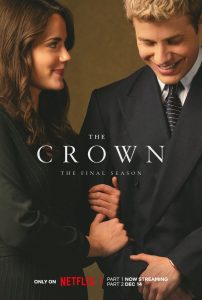 Professor Satya Narayan Misra in Bhubaneswar, December 23, 2023: Few series could irritate audiences as reliably as Netflix’s The Crown, whose sixth and final season was released on 16th November. The Crown has walked the tightrope between prestige drama and soapy nonsense. There has been affection too: at least 75 million viewers saw it worldwide and a glitter of awards like two Golden Globe awards for best TV series followed. But irritation reigns.
Professor Satya Narayan Misra in Bhubaneswar, December 23, 2023: Few series could irritate audiences as reliably as Netflix’s The Crown, whose sixth and final season was released on 16th November. The Crown has walked the tightrope between prestige drama and soapy nonsense. There has been affection too: at least 75 million viewers saw it worldwide and a glitter of awards like two Golden Globe awards for best TV series followed. But irritation reigns.
The series has been criticized for its portrayal of Prince Charles (too scheming), the Queen Mother (too nasty) and the Duke of Windsor (too Nazi). It has been called “crude’, cruel, intrusive, impertinent, and nonsense on stilts. Princess Diana’s ghost appearance to Prince Charles and then to the Queen as a kind of ministering angel in the sixth season has led one historian to call it “farcical- just a sick joke’. All the same, for a series covering five decades of British history and monarchy, it deftly incorporates events that shaped UK politics, culture, and national identity.
Season I revisits the smog of 1952 that killed thousands of Londoners. Season 2, the Profumo scandal that brought down a PM. Season 3, the Aberfan disaster, the mining collapse at Welsh that buried dozens of school children, whose death Elizabeth would later wish she had commemorated more swiftly as advised by her PM Harold Wilson. People have been fascinated by forgotten facts, including the finer details of the Suez crisis, the smog of 1952, and the fact that the late queen was once upon a time young!
The sixth season traverses the moments in 1997; the weeks leading to Diana’s death. Diana’s story is inextricable from the monarchy’s obsession with tradition and system; she was the family’s most talented exploiter of media and also its tragic victim. The series can be broken down into pre and post-Diana Crown and never recovers from her death! There are two ways of looking at The Crown. One is a soap opera, a royally expensive royal drama.
The other is to see it as an excellent education in what history is and what it it is not. A great deal of the Crown, even if you get to the ghastly cameo by Diana’s ghost, is manifest historical bunkum. Prince did not inadvertently cause his sister to be killed in a plane crash. Prince did not hint to John Major, the then PM, that Queen Elizabeth should abdicate. Major called it ‘ a load of malicious nonsense’.
 In its defence, The Crown does not claim to be history. It is merely a fictional dramatization that was inspired by real events. In doing so, it is following in a grand dramatic tradition of playing fast and loose with the facts. There is a porous line between history and historical fiction, says Dan Jones, the historian. Not for nothing Herodotus ‘ the father of history ‘ was also called ‘father of lies’. Just as a mountain might appear to ‘ take on different shapes from different angles of vision ‘, similarly a simple fact can appear differently to different people, wrote the historian EHCarr in his classic book “What is History?
In its defence, The Crown does not claim to be history. It is merely a fictional dramatization that was inspired by real events. In doing so, it is following in a grand dramatic tradition of playing fast and loose with the facts. There is a porous line between history and historical fiction, says Dan Jones, the historian. Not for nothing Herodotus ‘ the father of history ‘ was also called ‘father of lies’. Just as a mountain might appear to ‘ take on different shapes from different angles of vision ‘, similarly a simple fact can appear differently to different people, wrote the historian EHCarr in his classic book “What is History?
That does not mean there are no facts. As the famous filmmaker Akira Kurosawa depicts in his classic film Rashomon(1950) there are multiple realities rather than an exposition of a particular truth. History does not sit preserved from the pollution of fiction, like an insect in an amber. There is a two-way traffic between the past and the present. The royal family had watched The Crown and had been affected by it.
The series reportedly led the Queen to think about how she had treated her sister, Margaret. Historians might complain that Shakespeare’s Richard III is incorrect or that The Crown takes creative liberties, but both have something more powerful than accuracy: popularity. Crown’s connection also comes from the power of its small moments; such as the boys being told by Charles of their mother’s death, Harry writing’ Mummy’, the card that sits atop the coffin, or William hugging Charles in the rose garden after huge row holding him responsible for his mother’s death when Philip upbraids him for his palpable rudeness and unreason ability. It’s interesting to find how Tony Blair had a fawning admirer in the Queen, who was called King Blair.
The same Blair was called Liar Blair when the Britishers did not approve of Britain’s engagement in Iraq as a lackey of Bush. It shows how a deeply conservative institution like the monarchy was overtly comfortable with Conservative PMs like Churchill but took time to accept the change of guard to the Labour Party PMs like Wilson, who cared more for the hoi polloi.
 The National Health Service program in the UK was a major boon to the poor. This is where Diana succeeded, by connecting to the hoi polloi with her spontaneity and manifest affection. Her crusade for the land mine victims struck a deep chord with the masses and had a massive impact globally. In 1997 after the death of Princess Diana, Blair wanted the monarchy to be refurbished and modernised.
The National Health Service program in the UK was a major boon to the poor. This is where Diana succeeded, by connecting to the hoi polloi with her spontaneity and manifest affection. Her crusade for the land mine victims struck a deep chord with the masses and had a massive impact globally. In 1997 after the death of Princess Diana, Blair wanted the monarchy to be refurbished and modernised.
The sixth episode of Crown shows how the Queen considered any change to British heritage as unnecessary and an antithesis to Britain’s heritage. Blair’s spokesperson told The Daily Telegraph “This is complete and utter rubbish”. Yet the debate of monarchy being an anachronistic institution and an unnecessary drain on the public purse has not lost its salience. Crown might not be true history in the technical sense. However, that is not material. It will change how history is seen nonetheless, beyond our obsession with Diana and Williams as her mirror image.
Professor Misra is a film buff


Leave a Reply
Be the First to Comment!